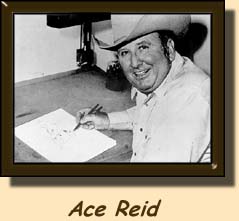Down our dusty, lonesome back road,
I often see one of God's creatures,
The small, sandy colored horny toad.

Some call him the Phrynosoma cornutum,
Or the Texas horned lizard, they say.
And he's been right around these parts
Four million years, give or take a day.
They say when the horny toad gets mad
It shoots a stream of blood from each eye.
Now, I never witnessed that act myself,
But I have no reason to believe it a lie.
Next time you see him lunching on ants
Or lying still, this famed horned toad,
Just enjoy his presence there alone
And go peacefully on down the road.
_____________________________________End.
Written at Snyder, Texas on Oct. 18, 1991. Based on
Bryan Wooley's article, "Ode to the Horny Toad," in the
July 14, 1991 issue of Dallas Life Magazine.
Ace Reid
by Stan Paregien, Sr.
Copyright 1991
Born at Lelia Lake, Texas way back in 1925,
Ol' Ace Reid's kid was busier'n a beehive.
Young Ace, Jr. grew up poorer than most poor,
In a three-room house with a toilet outdoor.
He was raised near Electra, on a big ranch,
Where he sometimes got whupped with a branch.
What was the devilment in him those days?
He was like a stud with the loco weed craze.
Ace delighted his second grade school mates
By drawing cartoons on the big black slate.
And even his teacher liked his funny stuff,
Though she had to rein him in often enough.
His first art studio was humble, it is true:
Just a chicken house with a table or two.
His family thought it was a waste of time,
But he felt each moment there was sublime.
Ace quit school his senior year in 1943,
And joined the Navy the world for to see.
Instead he saw death almost every day,
Reaching Nagasaki with bodies in the bay.
But all was not bad aboard that U.S. ship,
For Ace drew cartoons at a very rapid clip,
As the staff cartoonist on their paper small,
Getting positive strokes from one and all.
When Ace left the Navy with $2,000 in hand,
He returned to Electra to invest in land.
In 1947 his dad put his cartoons in the mail.
And, neighbors, therein hangs a Texas tale.
The Quarter Horse Journal liked 'em a lot,
Though $3.00 each is all that young Ace got.
But it got him thinkin' about the easy way,
Of cartooning instead of hauling hay.
Ace never liked to talk about it, you see,
But he studied art back in Washington, D.C.
In 1949 he turned toward thoughts of love,
And married Marge Parmley, his turtledove.
Ace and Marge moved to Kerrville in 1952,
And they figured success was just about due.
But the newspaper syndicates turned him down;
So he did it himself and showed those clowns.
Ace drew cartoons and they sold them about,
Traveling until they were about worn out.
Little by little his work caught on fire,
And the lecture circuit ol' Ace did aspire.
Now, Ace Reid, Jr. was nobody's silly fool,
Even though he did drop out of high school.
He took to lecturing like a bee to honey,
And pretty soon he was makin' bigtime money.

In 1961 he bought a ranch he had longed for,
And at the Draggin' S life was never a bore.
There he created the legend of a wild thing--
The South African Whamdoozie--and its praises
he did sing.
Ace was a rounder who drank a lot, they say;
He said he wouldn't have it any other way.
He knew human nature and fit into any crowd,
Even if his show biz persona was a bit loud.
His cartoons about Jake and Zeb hit the spot,
And folks all over the land love them a lot.
Ace showed our daily frustrations well,
With a humorous twist that rang the bell.
Ace died on Nov. 10, 1991 in ol' San Antone,
But, thanks to his work, we are not alone.
He showed how even a poor cowboy can succeed.
And we'll treasure the cartoons of Ace Reid.

__________________________________________End.
Written at Snyder, Texas on Nov. 18, 1991. Based
on the book by John R. Erickson, Ace Reid: Cowpoke.
The Education of a Lady
by Stan Paregien, Sr.
Copyright 1991
It was the refined lady's first visit
To a real, working Arizona ranch, you see.
She pointed at the pole corral and said,
"Oh, that reddish colored cow is lovely.
"But, Mr. Cowboy, where are it's horns?
If I don't get an answer I shall be forlorn."
"Lady, some cows don't have 'em until late in life.
And some cows are born without horns."
The old foreman spat tobacco on the ground.
"Others are bred to be hornless, of course.
But the main reason no horns do you see
Is because this cow is a mustang horse."
__________________________________________End.